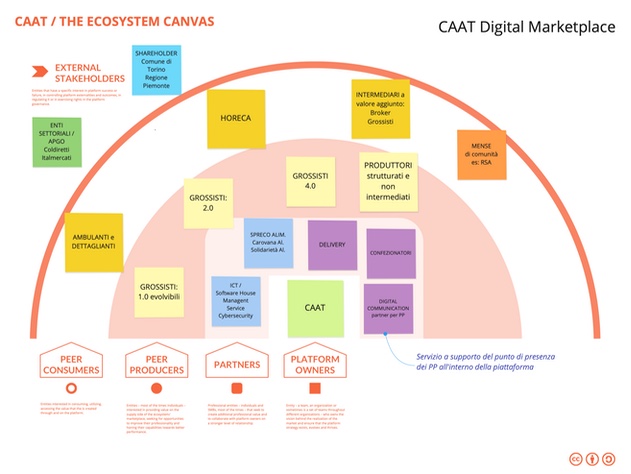Objective
This company’s responsibility is to design, develop, supply, assist, and maintain a Digital Ecosystem Platform with Software as a Service [SaaS] architecture that facilitates the interaction between the operators of the supply chain and the matching of demand and offer of agri-food products. The establishment of conditions that allow the CAAT service system to access segments of operators and users that are not currently present or have a weak presence. Digitise, synchronise, and eliminate phases which currently take place exclusively within CAAT’s physical structure.
The transformation taking place in all distribution processes is clearly perceptible, and the SARS-CoV-2 epidemic has greatly accelerated its progression. CAAT has long observed the rapid development of digital flows in the broadest sense, including e-commerce, user interface and user experience, hybrid work, mobile apps, transactions, payment, logistics, and delivery. This suggests the timing and importance of a digital transformation project that puts CAAT at its centre – as a result of the market’s role in the territory and in the sector – and explicitly conceives it as a perimeter around the entire agri-food value chain.

Description
The digital marketplace concept resulting from the 2021 strategic analysis is more complex, both in terms of functionality and objectives, than the simple implementation of an e-commerce site. In essence, this is how the system operates. The main objective of the project, however, is to re-design the current supply chain digitally, to include operators not currently present or poorly represented within the supply chain, to develop a CAAT Digital Twin with a significantly larger perimeter than the current one and to develop process methods that are currently unavailable. Among the most significant examples are the possibility of extending the supply chain to include delivery as well as overcoming the time constraints of operations in the “physical” CAAT.

The Marketplace
The Marketplace will therefore be of support to the Operators for the purpose of optimising the management of sales, as well as representing a privileged reference point to access the offer of the Operators’ products and to convey, in terms of communication and marketing, the values promoted by CAAT, including, but not limited to, the environmental, economic, and social sustainability of products and companies within the structure. The platform will include features that will reduce food waste by facilitating the meeting between the recipient associations of perishable goods and the operators in possession, and it will also facilitate the optimisation of the delivery process of the same goods.

As a result of the way sales and the related flow of use are managed, both on the Operators’ side and on the Buyers’ side, the free market will be respected and the Operators’ competitiveness will be enhanced. As a result, buyers will be able to access those commercial proposals that are deemed to be the most economically advantageous, as well as those that are available at the time of their bid request in respect of the service offered by each operator and the availability of the products placed in their basket.
The entire Marketplace will be developed in both Italian and French and will be prepared for further future localisation (language, date, and time). As far as accessibility is concerned, the platform will be compatible with the most common web browsers and mobile devices.
What we undertake to do
- encouraging the digitisation of commercial exchanges and transactions so that the Centre’s operators may intercept new demand, thus facilitating the development of the Centre’s activities and services;
- enhancing the value of individual companies, protecting their identities and historicity;
- ensuring compliance with the rules governing the formation of prices within the Centre, thus avoiding the formation of potential “cartels”;
- encouraging an extension of commercial operations also through the implementation of services such as, for example, picking, groupage and delivery;
- making available to operators a useful tool to increase their trade also at international level;
- Reducing food waste in conjunction with the new logistics hub, as well as technical and functional solutions to facilitate the meeting between non-profit associations and operators in order to optimise the redistribution of surplus food.
Digital Ecosystem Platform
In 2021, a strategic analysis project was conducted with CAAT, which is the rational basis for the Digital Marketplace project. Using the extremely current methods and tools of Design Thinking:
- an in-depth analysis and classification of internal CAAT operators has been conducted in relation to their readiness for digital transformation. It emerged clearly that the supply chain presents high levels of heterogeneity in terms of even partial adoption of digital processes, aptitude for process and product/service innovation, organisational culture, communication skills, digital presence [web, social media, storytelling], and organisational culture. Additionally, CAAT must become a proactive element of change, that is, implement initiatives that trigger and direct evolutionary processes in a digital context, setting the course for large segments of the supply chain;
- as part of this evolution, a central tool has been identified in the Digital Marketplace, and a reference model has been developed by analysing and adopting the concept of the Digital Ecosystem Platform. Because platforms, especially digital ones, serve as the reference model for many services with a wide spread spectrum, they have attracted much theoretical and commercial interest: all Social Media platforms, e-commerce, and the most advanced marketplaces, both B2C and B2B [AirBnB, Booking, Tripadvisor, Amazon, Alibaba, Behance, to name a few],
- An important characteristic of the Digital Ecosystem Platform has been positively evaluated: the explicit identification of two macro processes, technically called engines – that involve all actors participating within the ecosystem in different ways – and entities. The Transaction Engine is the functional operating core for managing transactions between entities, which includes access, accreditation, search and selection functions, orders, purchases, payments, and delivery. E-commerce is the paradigmatic example of this engine. The Learning Engine is a second engine designed and developed to trigger and develop the system of relations and communication between active entities. This functional layer contains the “soft” aspects of the Platform, with the purpose of co-evolving all participants.
- In an e-commerce model, the entities themselves are more articulated than the typification of the active subjects. The Digital Ecosystem Platform of the Marketplace obviously includes professional operators who offer their products and services [PP – Peer Producer] or buy them [PC – Peer Consumer]. Furthermore, it also includes Impacts Entities such as CAAT itself as owner and manager of the platform [PO – Platform Owner] and Stakeholders [PS] as entities and institutions. Though they are not directly involved in exchange processes, they are carriers of interests and expectations that are inherent to the digital ecosystem and its real effects. Among these there are also associations and other organisations that cooperate with CAAT and other entities, providing services and value to the ecosystem – [PA – Partner], such as associations in the third sector that operate in the field of combating food waste.
Output
Marketplace – an e-commerce platform with the features provided by the project; digital communication functions, both internal and external – contextual information push; digital point of presence for operators participating in the Marketplace.
